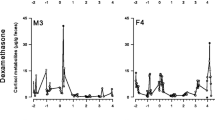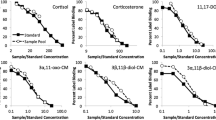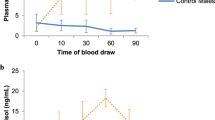Abstract
Increased production of glucocorticoids by the adrenal cortex is found in mammals under stress. As cortisol itself is absent in the faeces, an enzyme immunoassay (11-oxoaetiocholanolone) measuring 11,17-dioxoandrostanes has already been established to measure faecal cortisol metabolites in ruminants for non-invasive monitoring of adrenocortical activity. The aim of this study was to establish route and delay of excretion of glucocorticoids in hares and to determine whether a cortisol-, corticosterone- or this new enzyme immunoassay is best suited to detect faecal glucocorticoid metabolites. In the first experiment radioactive-labelled glucocorticoids (14C-cortisol and 3H-corticosterone) were administered intravenously to two groups of three hares in metabolic cages. All voided urine and faecal samples were collected for 4 days. Metabolites of both steroids were found predominantly in the urine (91 ± 4%). Peak concentrations were observed in the first urinary sample following infusion (13 ± 6 h) and in the faeces with a delay of about 1 day (23 ± 7 h). Most of the radioactivity was not extractable with diethylether, indicating that the metabolites excreted in urine and faeces are mainly conjugated or polar unconjugated ones. This was confirmed by reverse-phase high-performance liquid chromatography separations of the metabolites, which also revealed marked differences concerning the metabolism of the two glucocorticoids injected. Compared with the cortisol and the corticosterone enzyme immunoassay, only the group-specific enzyme immunoassay for 11,17-dioxoandrostanes detected high quantities of immunoreactive metabolites. In a second experiment hares (n=20) were stressed by rousing them three times (5 min, 10 min and another 5 min) with a 20-min break in-between. Faecal samples were collected 2 days before until 4 days after stress and analysed using the 11-oxoaetiocholanolone enzyme immunoassay. After stress significantly (P < 0.001) increased 11,17-dioxoandrostane concentrations were found. Based on these results, measuring 11,17-dioxoandrostanes in faeces enables non-invasive monitoring of disturbances in hares and thus provides a tool for field investigations elucidating the role of stress in hare populations.
Similar content being viewed by others
Author information
Authors and Affiliations
Additional information
Accepted: 24 November 1999
Rights and permissions
About this article
Cite this article
Teskey-Gerstl, A., Bamberg, E., Steineck, T. et al. Excretion of corticosteroids in urine and faeces of hares (Lepus europaeus). J Comp Physiol B 170, 163–168 (2000). https://doi.org/10.1007/s003600050271
Issue Date:
DOI: https://doi.org/10.1007/s003600050271




